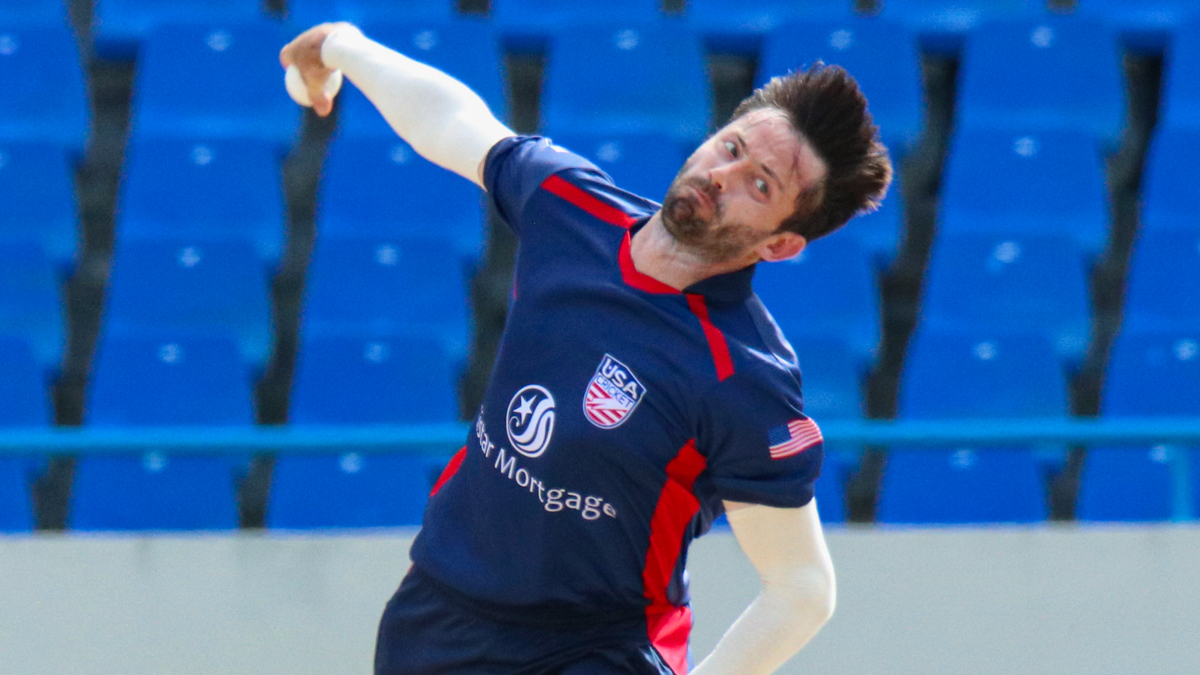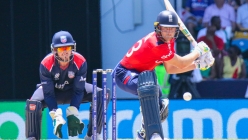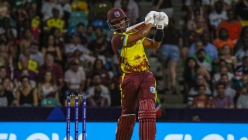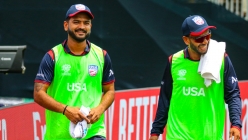Views
USA Cricket: 2021 ICC Americas Men’s T20 World Cup Qualifier Tour Report Card Part 2: Player Grades
2021 Dec 02 by DreamCricket USA

By Peter Della Penna (Twitter @PeterDellaPenna)Allrounder Ian Holland is the highest graded player in USA's squad on the tour of Antigua. See what everyone else wound up with in Part 2 of DreamCricket's Tour Report Card review of the 2021 ICC Americas Men's T20 World Cup Qualifier.
Image credit: Peter Della Penna
For those unfamiliar with how individual players have been graded in the past as part of DreamCricket’s post-tournament report cards, each player is evaluated with regards to their specific role in the team on a match-by-match basis and not solely based on aggregate stats.
Players who excel under pressure and against higher quality opposition are graded more favorably. Overall chances given by a batsman, as well as overall chances created by a bowler, are taken into consideration regardless of total runs scored or wickets taken. Bonus marks are given for good fielding while a player can also be downgraded for weak fielding including dropped chances. Players must also play in a minimum of 50% of the matches on tour to receive a grade.
With those guidelines laid out, here are DreamCricket’s player grades for the 2021 ICC Americas Men’s T20 World Cup Qualifier tour of Antigua. USA finished with a 6-0 record as undefeated tournament champions.
Steven Taylor: A-
The do-everything player turned 28 during the tour and set the tone from the first day with a Player of the Match performance against Belize, taking 1 for 5 in two overs before bashing an unbeaten 39 off 15 balls. Just as importantly, he set the tone once more against Bermuda with 25 off 17 as part of a 53-run opening stand in the Powerplay with Monank Patel. He then took two fairly big wickets in the chase, getting captain Kamau Leverock and Tre Manders, while also taking a safe but very important catch at deep square leg to dismiss Delray Rawlins. He played a terrible shot to get out cheaply against Canada, but then redeemed himself in the Super Over with two sixes to give USA the upper hand.
For the tour, he finished third on the team in runs with 70 in three innings at an average of 35, but with the highest strike rate in the squad at 179.48. He was also USA’s third most economical bowler on tour, taking his four wickets at an average of 10.00 and an economy of 4.00 in 10 overs. Aside from his one catch, he also contributed to three runouts and continues to be one of USA’s most valued allround fielders. As USA’s most capped player in T20 cricket, he put all of his experience to good use on this tour to make up for a limp showing in Bermuda two years earlier.
Monank Patel: B+
The USA captain scored 51 runs in three innings at an average of 25.50 while leading his side to an undefeated tournament title run. He scored a vital 30 off 16 balls as part of the 53-run opening stand with Taylor to kickstart USA’s victory over Bermuda. Like Taylor, he played a poor shot to get out cheaply against Canada one match later and didn’t bat again for the rest of the tourney while other players were given chances as part of USA’s rotation policy against weaker teams.
The most impressive part of Monank’s tour though was arguably his wicketkeeping. He completed five catches and five stumpings without any clear or obvious dropped chances committed. His rotation of bowlers was also generally sharp as captain. Ending his first tour in charge with an undefeated tournament title run is quite a feather in his cap and, to state the obvious, it will only help his confidence as a leader grow going forward.
Xavier Marshall: B-
The 35-year-old finished second on tour in runs with 113 at an average of 37.66. But that was partly a function of getting a few more opportunities with the bat than most others. That included a 47 not out against Panama where he was dropped twice, initially on 5. Marshall scored 19 off 16 against Bermuda at No. 3, then 28 off 25 balls against Canada from the same position. The Canada score can be read two different ways: he kept the batting afloat when the rest of the top five failed, or he stalled USA and put pressure on his partners by failing to rotate the strike because 14 out of his 25 deliveries were dot balls.
In the field, Marshall gets upgraded because of his energy and demeanor generally lifts up his teammates. He gets downgraded though for two missed chances, most notably a runout chance when Tre Manders was on 28 and went on to make 49. This tour was better for Marshall than the miserable experience he had in Bermuda two years ago when he was USA’s worst player. But a player of his stature and reputation should still be making more meaningful contributions at international level than he produced.
Aaron Jones: A-
The vice-captain ended as USA’s leading scorer on tour with 130 runs in five innings at an average of 65.00. In all the drama that unfolded during the Bermuda encounter, his Player of the Match performance quietly slipped under the radar as he scored a key 50 off 33 balls to keep USA’s momentum going after Taylor and Monank got out at the end of the Powerplay. He failed against Canada but succeeded against the lesser teams, though he did offer a few chances during his other unbeaten knocks.
Jones bowled five overs of his part-time legspin, taking one wicket. As for his fielding, Jones is solid but not spectacular. He took an above average catch with a backpedaling dive to dismiss Kamau Leverock in the Bermuda game, but also dropped two chances in the Bahamas match, though one was a result of a collision with Netravalkar. Overall it was a typically efficient tour performance from Jones, the kind he has built his reputation on since entering the USA squad in 2018.
Gajanand Singh: B
Scored an unbeaten 50 off 38 balls to be Player of the Match in the win over Argentina in his only innings of the tournament, showing he was serviceable in his role as the reserve batsman on tour. It should not escape anyone’s attention though that he was left out of the starting XI for USA’s two most important matches of the tour against Bermuda and Canada. In the field, he took one catch on the deep midwicket boundary and dropped no chances. Gajanand served his role in the squad well.
Jaskaran Malhotra: B
Like Marshall, Malhotra did less with more chances than most in the touring party. He scored 69 runs in four innings. However, his best score of 35 came at a very critical time against Canada when USA was floundering in their chase of a target of 143 by scoring 35 off 25 balls at No. 7. It was a peculiar innings because while his maneuvering of the field was good, his running between the wickets was atrocious and a point can be made that the match should not have gone to a Super Over if Malhotra had shown even the slightest bit of interest in turning ones into twos while at the crease with both Nisarg Patel and Karima Gore. At the end of the day, he top-scored in the innings for USA but there’s a reason why Gore was named Player of the Match over Malhotra.
Malhotra took no wickets in four overs of spin. In the field, he was sloppy at times, missing a total of three chances. However, his utility came in handy when Monank went off injured in the final match and moments later Malhotra took his only catch of the tournament while keeping to Nisarg. Like Marshall, Malhotra had a better tournament than he had two years ago in Bermuda but still should be doing more with the opportunities he had at the crease.
Nisarg Patel: B+
The allrounder was USA’s leading spinner on tour, finishing with seven wickets at an average of 12.85 and an economy of 4.73. He rounded off the tour with a Player of the Match performance in the win over Bahamas, taking 4 for 17. However, he played a quietly pivotal role in both the Bermuda and Canada matches, resulting in a bump up in his grade above some other players with similarly mediocre-looking stats.
Against Bermuda, he was out for 5 off 6 balls. However, he took the massive wicket of Delray Rawlins in the only over he bowled, bravely continuing to flight the ball just after he’d been dragged through the leg side for a boundary. The follow-up resulted in a top-edge swept to Taylor at deep square leg. Against Canada, he helped rein in Canada during the middle overs with 0 for 16 in three overs, which was by far USA’s most economical bowling spell in the match. Just as crucial was his batting contribution, scoring 25 off 24 balls in a 42-run partnership with Malhotra to lift USA back into the match after they were reduced to 44 for 5. Essentially, both he and Malhotra built a bridge to get USA across a deep valley before a host of other heroes pitched in to take more of the credit at the finish. But Nisarg’s role as an unsung hero in that match should not be forgotten.
Nisarg had one wicket dropped off his bowling in the match against Panama but still managed to finish in the top 10 wicket-takers list overall at the tournament. He took one catch and dropped none, and also contributed to one runout. Overall, this was one of Nisarg’s better tours. The key is to maintain that consistency on future assignments.
Ian Holland: A
USA’s highest graded player on tour. Quite simply he was a monumental difference maker with the ball, shifting momentum in every match and often times in his very first over. He ended the tour as USA’s leading wicket-taker claiming 10 wickets at an average of 8.90 and an ecomony od 3.86. He took at least one wicket in every single match, and never more than two. His consistency was immensely valuable, not to mention remarkable.
He took Player of the Match honors for his spell of 2 for 3 paired with USA’s best catch of the tournament at long-on against Panama. Against Bermuda he struck with his very first ball after being brought on in the fourth over, then got his second just four balls later to claim both Allan Douglas Jr and Dion Stovell in what was nearly a double-wicket maiden before Rawlins spoiled the final ball by clipping a two. Against Canada, he began with a wicket-maiden by striking on his second ball to bowl Hiral Patel, then removed Hiral’s opening partner Rayyan Pathan in his next over with another full and straight delivery to knock back the stumps. He arguably should have had a third wicket in the Canada match when Rusty Theron misjudged a chance in the deep when Navneet Dhaliwal was on 27 before going on to make 44. He also had another wicket dropped off his bowling in the Bahamas match, otherwise he would have ended as the tournament’s leading wicket-taker.
The only thing stopping Holland from getting an A+ were his two low scores with the bat in the Bermuda and Canada games. However, he ended the tournament on a high note on the batting side, scoring an unbeaten 39 alongside Jones in a 91-run unbroken partnership during USA’s 10-wicket win over Bahamas. There was no more impactful player for USA on tour than Holland.
Karima Gore: B
Gore’s statistical returns with bat and ball may look meager, but a major part of his grade derives from his Player of the Match performance in the win over Canada. Few people would have regarded him as a traditional finisher prior to his arrival at the crease that afternoon, but his 31 off 15 balls before he was given out lbw on the penultimate delivery of regulation put USA in position to reach the Super Over where they prevailed. Gore’s other batting contribution was 12 off 10 balls in the win over Bermuda.
With the ball, Gore’s contributions continue to mystify. His form with the ball his seemingly fallen off a cliff since he sustained a hamstring injury on the tour of the UAE in December 2019. He bowled one over in the Bermuda match, conceding 16 runs, and against Canada gave away seven runs off the only six balls he bowled. He started off the tournament with 2 for 13 against Belize, but didn’t take another wicket the rest of the way in a total of nine overs before sitting out the final two matches.
As for his fielding, this continues to be Gore’s greatest asset. He cut off countless singles from inside the ring, but also took two catches in the tournament, one of which was a highly underrated effort at deep midwicket just inches inside the boundary rope to remove Canada captain Dhaliwal on 44. His performance in the Canada match was immense, but he was fairly quiet otherwise and the lack of bite in his bowling remains a significant concern going forward.
Rusty Theron: A-
Much of the attention for Theron over the last month has been in his role securing the greatest and most dramatic two byes in American cricket history. But that would obscure the superb tournament he had throughout as a medium pacer for USA. He finished second on the team with eight wickets despite playing just four matches. Like Holland, he took wickets in every single match he played.
Theron’s tournament started off with 3 for 16 against Belize on the opening day before he took 2 for 31 against Bermuda. His new-ball spell was expensive before he came back later to help wipe out Bermuda’s lower order for both of his wickets. Against Canada, he was similarly expensive with the new ball before coming back with a solid late spell that included teaming up with Gore for the wicket of Dhaliwal in the 18th over, denying Canada’s set batsman a chance to launch in the final overs, and he ended with 1 for 27. His other performance came against Argentina where he took 2 for 5. He also had a chance dropped off his bowling against Bermuda which could have resulted in a third wicket when Malhotra dropped a skied top edge at short fine leg in the waning overs.
With the bat, he scored an unbeaten 7 off 3 balls against Bermuda, which was solid considering the rest of the middle-lower order’s failures that resulted in USA being bowled out with two balls unused. And against Canada, he may have scored the most legendary 1 not out off two balls there ever will be in American cricket history. The only thing keeping Theron from an A or A+ is his lack of new-ball breakthroughs against Bermuda and Canada, but overall he was one of USA’s best performers on tour.
Saurabh Netravalkar: C
Netravalkar’s ODI stats are quite remarkable. His T20 stats though are very unremarkable and the same held true for this tour. Netravalkar's lack of wickets in T20 cricket is quite confounding considering his very skillful array of variations and his success as a death bowler in 50-over cricket, which somehow has not translated similarly into the shortest format.
The former T20I captain took figures of 1 for 7 against Belize – as well as a misjudged chance by Marshall at deep square leg which should have been a second wicket – and 1 for 6 against Panama across five overs. However, he was hit hard by both Bermuda and Canada, conceding 0 for 28 in three overs and 0 for 27 in four overs respectively. He generated no chances in either game. One has to wonder if, to borrow a baseball term, Netravalkar is tipping his pitches on his approach to delivery.
In the field, Netravalkar continues to be a liability and his positioning at long-on for various stretches was confusing since that is traditionally a catching position outside of the Powerplay when teams a slogging straight down the ground. He dropped one chance there off Nisarg Patel in the Panama match, and was also responsible for a dropped chance by Aaron Jones in the Bahamas match when the two of them collided while going for a skied catch in the ring. Netravalkar is a very smart man, so even he must realize that when he is one of two teammates going for a skied catch, he should be deferring to whoever is the other player calling for the ball on every occasion because he is far from sure-handed at the best of times.
If Netravalkar was an elite fielder like Gore, it’s understandable that team management would have patience for a dip in bowling form. But his poor performances in T20Is have gone on for awhile now. Though he has been a handful to face in MiLC T20s against domestic competition, international level productivity is a different matter. Selectors may need to take a hard call on his spot in the squad for the T20Is coming up against Ireland, and for the global T20 World Cup Qualifier too.
Ali Khan: B+
The speedster only played three games for USA but was a significant contributor to USA’s reversal in fortunes from two years ago when he missed the T20 Qualifier in Bermuda due to an ankle injury suffered in a training session on the eve of the event. On paper, his stats show he took three wickets at an average of 21.00 and an economy of 5.72, but it’s hard to put a figure on the renewed confidence and swagger that USA’s entire squad held whenever Khan had the ball in his hand.
He started off the tournament with figures of 1 for 17 against Panama but then produced a very influential 1 for 12 in four overs against Bermuda. On a day when the required run rate was nearly nine per over and in an innings where Bermuda went at 7.45 an over, Khan went for less than half of that in a marvelous performance. More than that, the attitude he brought to the field showed that USA was a different team from the meek and timid group of two years prior.
Against Canada, his early spells were average but his value at the death showed up again when he conceded just five singles and claimed the wicket of the well set Ravinderpal Singh in the 20th over, which wound up being monumental in the end context of the match. Canada was well on course to pass 150 with seven wickets in hand but instead ended on 142. With 22 runs to play with in the Super Over, he had victory clinched for USA with two balls to spare.
With the bat, Khan’s first-ball duck against Bermuda was somewhat irresponsible considering all that was necessary in the situation was getting a single to put Gore back on strike. On the final ball against Canada, he swung and missed to trigger the first bye run by Theron, though a strong argument could be made that three byes could have been run to complete a USA win instead of the two byes that USA settled for in the moment had Khan continued running throughout the sequence. Khan’s head was off in the clouds after the first run, caught up in his own frustration at missing the final ball and it was really Theron’s yelling that woke Khan up to the second tying run.
In the field, Khan had no catches and no drops. He is generally reliable wherever he is stationed. Overall, the stats might not say indicate as much but the reality is that Khan had a big impact on USA’s performance in the tournament and demonstrated how one player’s skillset can make a massive difference in T20s.
Elmore Hutchinson: Incomplete
The 39-year-old sat out until the final two matches when a spot in the global T20 World Cup Qualifier had already been secured. He took 2 for 7 against Argentina, starting off with a double-wicket maiden in the third over of play. He did not take any more wickets in the rest of his spell against Argentina or a match later in his two overs against Bahamas. Hutchinson did not bat at all in the event.
Hutchinson’s longevity is remarkable, and he is a beloved member of the USA squad both inside the team and by many fans on the outside. But a serious discussion needs to be had about whether or not he should still be touring at his age if he is not a first-choice player when his spot could be used to groom a younger long-term prospect for the future.
Trinson Carmichael: Incomplete
Like Hutchinson, the 29-year-old left-arm spinner sat out the first four matches before coming into the XI for the final two contests against Argentina and Bahamas. As he has done in MiLC T20 with his franchise team, Empire State Titans, Carmichael took the new ball for the first over against Argentina, but was ineffective conceding nine runs and ended the day with 0 for 25 in four overs. Similarly, he went wicketless against Bahamas ending with 0 for 18 in two overs and ended the tour as USA’s most expensive bowler in terms of economy rate, bleeding 7.16 per over. This is even more alarming considering the fact that fingerspinners are meant to be far more economical than any other bowler in T20 cricket, and that his performances came against two of the weaker teams in the competition.
On the whole, Carmichael looked extremely nervous on the field. This was borne out by a number of misfields committed on debut against Argentina while stationed at backward point, a position that he has filled at domestic level with good results thanks to his footspeed along the ground at cutting off singles as well as his sure-handed catching. However, he shook off some of those nerves in the field against Bahamas, where he took a catch and sparked a runout from backward point on consecutive deliveries in the 17th over of the innings. Carmichael did not bat at all in the event.
It would be harsh to drop a player from USA’s next touring squad after just two matches, but equally it would be unsurprising to see it happen in this instance considering Carmichael’s underwhelming contributions against the standard of opponent he was bowling to.
[Views expressed in this article are those of the author, who was present in Antigua for all six of USA’s matches, and do not necessarily represent the views of DreamCricket management. If you have different views or opinions, we respect those views and urge you to provide your feedback, both positive and negative. Feel free to respond to the author via Twitter @PeterDellaPenna.]
ICYMI - Part 1: Team Grades




